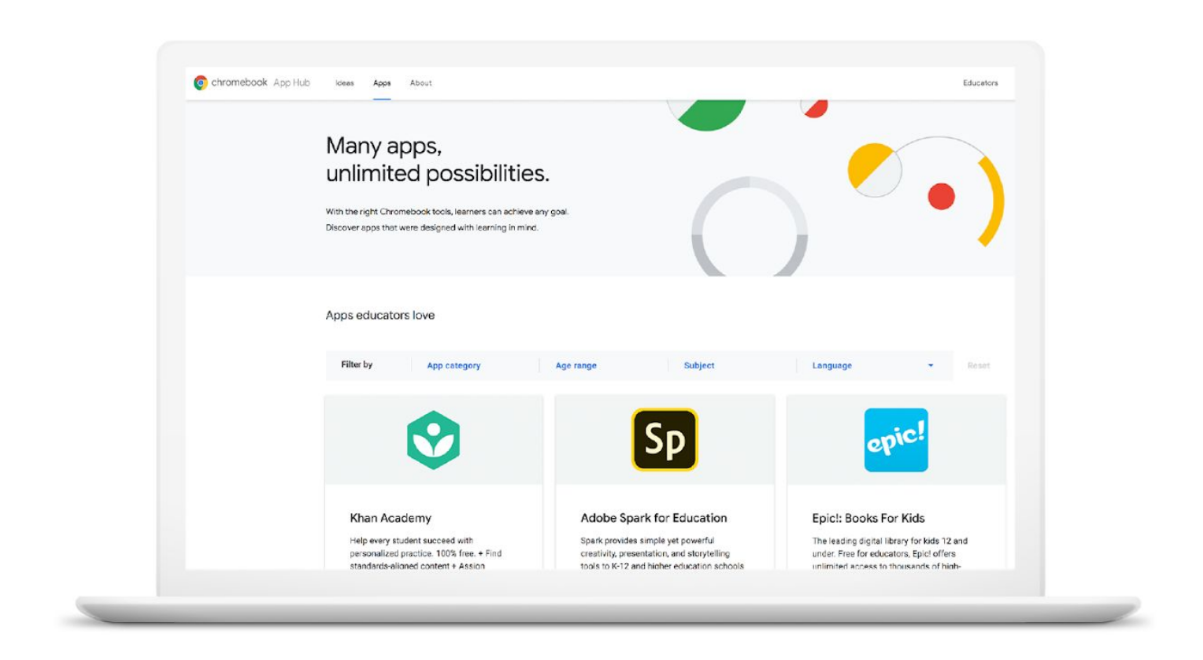 APPS
APPS
 APPS
APPS
 APPS
APPS
Google LLC is making some significant updates to its Google for Education learning suite today, adding new tools and service to help teachers streamline their grading workflows and find better apps to help with their classroom lesson plans.
Google for Education is essentially a customizable version of Google’s G Suite product. It offers several Web applications with similar functionality to traditional office suites, including Gmail, Hangouts, Google Calendar, Drive, Docs and Sheets.
The products are designed to be used on Google Chromebooks, which provide access to dozens of other third-party applications for classroom use. The suite is also meant to help teachers with their administrative tasks, enabling them to free up more time to spend with individual students.
One of the most time-consuming tasks for teachers is grading their student’s work, and Google for Education is trying to help with this in several ways. For example, Google is adding the ability for teachers to create and grade rubrics, which are scoring guides used to evaluate the quality of students’ constructed responses.
“Instructors enrolled in the beta program can create a rubric and attach it to an assignment, giving students full visibility into how their work will be evaluated,” Brittany Mennuti, a Google Classroom product manager, wrote in a blog post. “Instructors can then use rubrics while grading to select rating levels and give consistent and efficient feedback.”
Meanwhile, Gradebook, a feature previously available in beta that allows teachers to track student’s grades over time and evaluate their performance, is now generally available. There’s also a new beta feature that allows teachers to synchronize students’ grades with their school information system of record, which eliminates the need to enter this data into two separate systems, freeing up more time for teachers and eliminating the possibility of data errors.
Google is also making available a “locked mode” in Google Forms, which is a beta feature teachers can use to deliver classroom quizzes or tests to their students. With locked mode, students are prevented from being able to navigate away from the quiz until all of their answers have been submitted, helping them to focus on the task in hand.
On the learning side, Google is consolidating the numerous third-party educational apps and tools available on its Chromebooks under a new “Chromebook App Hub.” It’s basically a kind of marketplace for all of the educational apps on Google, but it also serves as a place for teachers and developers to share ideas on how these apps can be used in the classroom, and for lesson planning.
“After finding the perfect app, educators can browse ideas and inspiration from fellow educators,” Google explained in a post. “We’re working with EdTechTeam and educators to gather ideas around using apps in the classroom. These include tips for success, differentiated instruction strategies and links to additional resources such as how-to videos, activities and websites.”
Some of the apps available at launch include Epic!, a digital library of thousands of children’s books, and hundreds of videos and quizzes; Adobe Spark, which allows kids to access and create visual stories; and a free library of math, grammar, science and history lessons for teachers created by the Khan Academy.
The final update also relates to grading, only this time round Google is giving teachers a way to assess their students’ skills with G Suite itself. In a blog post, Google for Education program manager Taryn Hartzell noted that proficiency in digital tools such as G Suite is an essential skill in today’s job market, so it would be useful for students to be able to demonstrate their abilities in a transparent way.
Enter the G Suite certification, which is a test for students aged 13 and above that requires them to show “mastery of G Suite and other critical tools to help them succeed after school.”
Google already offered such a test for business users and students in higher education, but this one has been designed specifically for K-12 students. The test is also 50% cheaper, at just $37 per student, and comes with various training materials to help teachers prepare their students ahead of time.
“The battle for the classroom between Microsoft and Google is in full swing, and today it’s Google’s turn to become stronger,” said Holger Mueller, principal analyst and vice president of Constellation Research Inc. “These vertical extensions are good for educators who value more productivity. The certification for students on G Suite is a very smart move, because students will in the future need to demonstrate their workplace proficiency.”
Support our mission to keep content open and free by engaging with theCUBE community. Join theCUBE’s Alumni Trust Network, where technology leaders connect, share intelligence and create opportunities.
Founded by tech visionaries John Furrier and Dave Vellante, SiliconANGLE Media has built a dynamic ecosystem of industry-leading digital media brands that reach 15+ million elite tech professionals. Our new proprietary theCUBE AI Video Cloud is breaking ground in audience interaction, leveraging theCUBEai.com neural network to help technology companies make data-driven decisions and stay at the forefront of industry conversations.